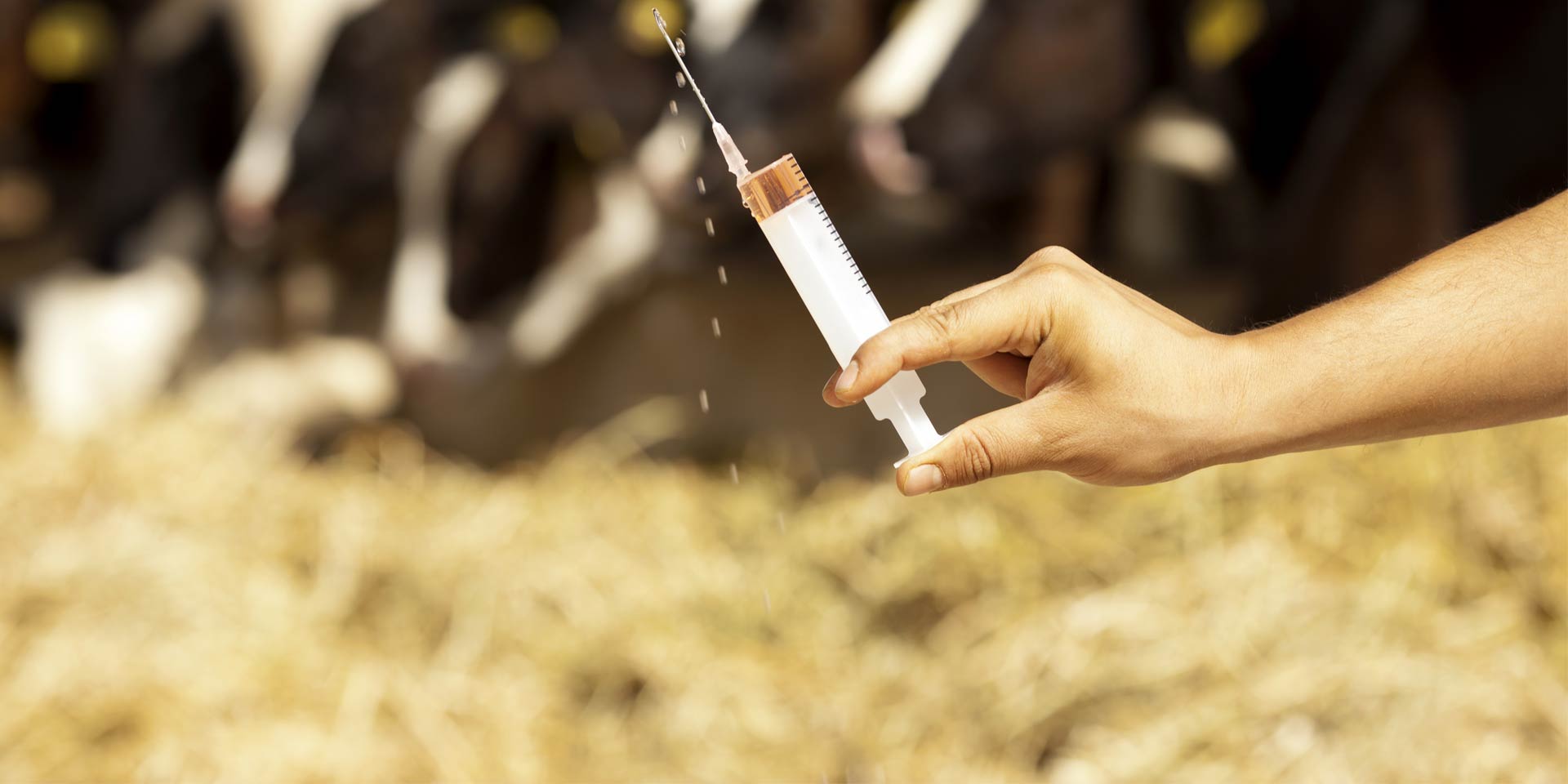We might be tempted to believe that most antibiotics are distributed to people through pharmacies and hospitals. The reality, however, is surprising.
In the United States, around 80% of antibiotics are used on animal farms for growth acceleration and sickness prevention[1]. In Europe, things are a little bit better, but the situation is far from ideal. A recent official report indicates that (in the context of certain methodological limitations—for instance, statistics from some countries did not include the quantities used in hospitals) the use of antibiotics on farms is at around 70%.
Antibiotic-resistant staphylococcus
“Pork meat sold by some of the leading British supermarkets has been found to be contaminated with a strain of the MRSA superbacteria, which is linked to the overuse of strong antibiotics on factory farms”, a Guardian investigation revealed. According to the British publication, the analysis of 100 samples of minced pork meat, bacon and ham or smoked ribs revealed that nine of them were infected with a strain of the Methicillin-resistant Staphylococcus aureus, strain CC398.
Staphylococcus aureus is a bacteria species which can produce a wide range of infections, of different severity. Although the staphylococcus was sensitive to penicillin, shortly after its launching, the staphylococci easily adapted to the new conditions: they started secreting an enzyme called penicillinase that inactivates penicillin and allows the staphylococci to stay alive.
In those years (1940-1960), humanity was, however, enthusiastic about the possibility of winning the war with bacteria, so researchers started launching new antibiotics. Among these we also count methicillin, an antibiotic capable of inactivating staphylococci despite their penicillinase secretion.
Methicillin was launched in the U.K. in 1959. Only a year after the launch, a British study already identified methicillin-resistant staphylococcus strain. Other reports identified, initially less frequently, then more and more frequently, cases of methicillin-resistant staphylococci. These resistant staphylococci are known under the abbreviation MRSA (“Methicillin-resistant Staphylococcus aureus”), as opposed to those who are still sensitive, known as MSSA (“Methicillin-sensitive Staphylococcus aureus”).
Infections caused by MRSA are difficult to treat because the germ is not only resistant to penicillin and methicillin but also to most known antibiotics: aminoglycosides (e.g. kanamycin, gentamicin), macrolides (e.g. erythromycin), fluoroquinolones (e.g. ciprofloxacin, ofloxacin), chloramphenicol, tetracyclines (e.g. tetracycline, doxycycline).
The CC398 strain (clonal complex), discovered in the meat in Great Britain, proved harmless until now. However, its germs have become increasingly isolated in infections in people who have not been in direct contact with live animals, and, although some important virulence factors are missing, there are indications that a subpopulation of this strain has the potential to colonize and infect humans.
With over 25 million pigs slaughtered annually (the biggest exporter in Europe), Denmark represents a potential reservoir of the microorganism. This fact is also confirmed by the investigation conducted by The Guardian. Out of the 100 samples analyzed in this investigation, 74 were Danish, 25 British and one Irish. Not necessarily surprising and somewhat politically correct, eight of the samples which tested positive for the germ came from Denmark, one from Ireland and none from Great Britain.
A coincidence or not, on the same day, the 18th of April, an article appeared in Eurosurveillance, a well-known scientific journal published by the European Centre for Disease Prevention and Control (ECDC). This article presented the analyses of 103 samples of meat from British supermarkets coming from British farms, 52 being pork samples and 51 poultry. In three of the pork meat products staphylococci belonging to the CC398 strain were identified.
Where do most antibiotics end up?
The fact that the staphylococcus originating in pig farms is methicillin-resistant has been convincingly related to practices for the use of antibiotics in livestock farms. In the main animal husbandry model for industrial purposes (for the production of meat or other animal products), thousands of animals are kept in the same shelter and, among other things, fed relatively low (subtherapeutic) doses of antibiotics, of which three quarters are not absorbed by the body and end up in manure; hence, by using it as a fertilizer, antibiotics can reach the plants. However, not only antibiotics were identified in the manure, but also antibiotic-resistant microorganisms, which persist in the environment.
In the context of an increasingly alarming in the number of antibiotic-resistant microorganisms and of the de facto drying up of the process of discovering new antibiotics, a bleak outlook on the future of humanity, which ordinary people do not anticipate, pressures authorities in different areas of the world to come up with a solution. Among others, a limitation of the use of antibiotics in farms is proposed.
The Food and Drug Administration in the U.S., a reference authority for many states of the world, adopted at the end of 2013 a guide recommending pharmaceutical companies a number of measures to facilitate the phasing out of antibiotics for production purposes (other than the treatment of animal diseases). Besides modifying the indications for veterinary antibiotics, one also aims for the change in classification, from over-the-counter products to products administered on a prescription basis or with a similar regimen, which would involve their use being monitored by a veterinarian.
The European Commission has also drafted legislative measures which include, among other, mandating the Commission to completely exclude or restrict the use of certain antimicrobial medicines for veterinary purposes and to adopt stricter rules in the field of advertising antimicrobial products for veterinary use. Measures are also proposed to effectively collect data on sales and use of antimicrobial drugs in animals and humans and on antibiotic-resistant organisms, identified in animals, humans and food.
From food into the human body
Beyond the risk of microbial resistance to antibiotics, does the fact that industrial animal farms frequently use large quantities of antibiotics and other antimicrobial medicine have any impact on the human health? These remain for a period in the animal’s body. From there they can reach the human body, through slaughtering for consumption reasons.
Consumers feel justified to ask question about the impact of the medicines that reach their body indirectly, via the animals. For instance, Lauren DeCuir, a young mother from New York, a culinary art graduate, was complaining on a blog, a while ago, about the weird taste and stringy texture of chicken meat and also launched the explanation: an FDA piece of news (from 2011) confirming the presence of arsenic in chicken meat from the U.S. “This cancer-causing toxic chemical, that in high doses could kill you, is actually being added to chicken feed on purpose, giving store-bought chicken the illusion of healthy coloring and plump appearance. Shockingly, this is the case with more than 70 percent of all U.S. chickens! That is just awful!” the young woman says.
The reality is a bit more nuanced. The substance is not really arsenic, but an arsenic-based drug (roxarsone), authorized for the first time in the U.S., in 1944 and used until 2011 to control coccidiosis, a parasitic disease causing gastrointestinal disorders in poultry and that contributes to them gaining weight. Being at the same time a nitroderivative, the drug gives a more intense color to the meat of the animals that consumed it, so that, although its official use was meant to control coccidiosis, it’s hard to say in how far preoccupations with the animals’ welfare are overshadowed by marketing ones.
In any case, scientific research has shown that arsenic in organic chemical combinations (like roxarsone, a less toxic version of the feared substance), can turn into inorganic arsenic (which is much more toxic) in the environment and even inside the animals’ body. Stimulated by these discoveries, FDA researchers conceived a method capable of detecting very low levels of inorganic arsenic in foods and came to the conclusion that the liver of chicken treated with roxarsone contains small levels of inorganic arsenic. At these levels, it is unlikely for the substance to have toxic effects. These levels are, nevertheless, higher than those found in the liver of chicken that have not been treated with the roxarsone-based antimicrobial product.
Following this conclusion, the company Pfizer, which sold the product in the U.S. decided (in 2011) to voluntarily suspend its marketing. Long story short, the marketing of the last veterinary medicine based on arsenic in the United States, came to an end in 2015.
From theory to practiceFortunately, the antibiotics and antimicrobial compounds which are currently being used do not contain arsenic. Furthermore, there are strict rules at European Union level regarding the possibility of using certain medicines in the treatment or prevention of certain animal diseases and regarding the maximum amount (limits) of drug waste that can be found in food of animal origin. Maximum residue limits of medicinal products are also used in the definition of so-called “waiting periods”. They designate the time elapsed from the last administration of a veterinary medicinal product, under normal conditions of use, according to the marketing authorization, to the manufacture of foods derived from the meat of those animals – in interval calculated to ensure that residues of medicinal products in the respective foods do not exceed the maximum residue limits set (at European level) by the competent authority. |
It’s not the arsenic derivatives we should be worried about
Paradoxically, it is not arsenic derivatives that should be the main concern of animal products consumers, but antibiotics. Antibiotics which are not found in large enough quantities to produce harmful effects in the human body, but which contribute to the training of microorganisms against antibiotics.
Antibiotic resistance could radically change not only pharmacology, but also our future society. If, through the irrational use of antibiotics, humanity was to select germs resistant to known antibiotics (which is not at all a farfetched scenario, but a rather a plausible one under the current circumstances), we would not only go back in time, to the days when there were no antibiotics. This would be even worse, because there would be no hope of a remedy that mankind would have had at some point and lost.
Robert Ancuceanu, PhD, is a professor in the Faculty of Pharmacy at the Carol Davila University of Medicine and Pharmacy in Bucharest, Romania.














